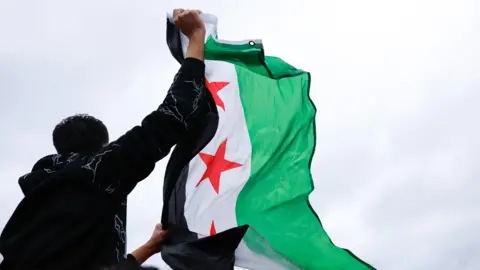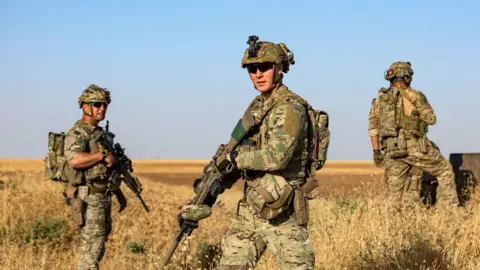 EPA
EPAA stunning advance by Syrian rebels ended Bashar al-Assad’s 24-year-long rule, with opposition forces taking the capital and forcing the president to flee on 8 December.
The overthrow followed a 13-year civil war, which started after Assad crushed pro-democracy protests. The fighting killed more than half a million people, displaced millions more, and embroiled international powers and their proxies.
The world is now watching to see how Syria’s political landscape shapes up after the end of the Assad family’s half-century rule.
Those with a vested interest in the conflict and the future of the country include, on one side, Russia and Iran – which backed Assad – and on the other, the US and Turkey, which supported different rebel groups and militias.
Here we explore how those countries, along with Israel, have played a role in Syria – and could continue to do so.
Turkey
During Syria’s civil war, Turkey has supported rebel factions – most of which now fight under the banner of the Syrian National Army (SNA) – by providing arms, military and political support.
Syria’s northern neighbour has mostly been concerned with using rebels to contain the Kurdish YPG militia, which Turkey accuses of being an extension of a domestically banned Kurdish rebel group, the PKK. Turkey also wants the roughly three million Syrian refugees living in its country to return home.
The YPG is the biggest militia in the US-backed and Kurdish-led Syrian Democratic Forces (SDF) alliance, which controls much of the north-east of the country.
The SDF largely avoided conflict with Assad’s forces during the war. However, Turkish troops and allied rebels seized stretches of territory from the YPG and SDF along Syria’s northern border.
Turkey has also been politically involved. In 2020, Turkey and Russia brokered a ceasefire to halt a push by the government to retake Idlib, the rebels’ stronghold in the north-west.
Idlib was dominated by the Islamist militant group Hayat Tahrir al-Sham (HTS), which led the rebels who eventually overthrew Assad.
Many believe the offensive could not have happened without Turkey’s blessing. Turkey has denied backing HTS.
Meanwhile, conflict in Syria’s north continues: At the same time as HTS launched its offensive, the SNA launched a separate assault on areas held by the SDF.
Russia
Russia already had a decades-long relationship with the Assad government, and had military bases there before the civil war.
Russian President Vladimir Putin used his country’s presence in Syria, and support of Assad, to challenge the power and dominance of the West in the region.
In 2015, Russia launched an air campaign and sent thousands of troops in support of the Assad regime.
In return, Russia received 49-year leases on an air base and naval base, which provided crucial hubs in the eastern Mediterranean for transferring military contractors in and out of Africa.
This marked an important stage in Russia’s attempt to assert itself as a global power, previously focusing its efforts on nations that were once in the Soviet bloc.
But fighting a war in Ukraine since 2022 preoccupied Assad’s ally, contributing to the Syrian military’s swift defeat to rebel groups in late November and early December.
Assad and his family were granted asylum in Moscow after fleeing Damascus, Russian media reported.
 AFP
AFPUS
After Syria’s pro-democracy protests in 2011 were met with force, then US-president Barack Obama backed the opposition to Assad’s rule.
The US provided military support to what it considered moderate rebel groups and intervened militarily in order to combat the Islamic State (IS) group in 2014.
A US-led global coalition carried out air strikes and deployed special forces to help the Kurdish-led SDF alliance capture territory once held by IS in the north-east.
After the Assad government fell, the US government said it conducted dozens of air strikes against IS camps and operatives in central Syria to ensure IS could not take advantage of the unstable situation.
President-elect Donald Trump, who takes office in January, said Syria is a “mess” the US should stay out of. When Trump was president in 2019, he ordered the withdrawal of US troops from Syria, a move his officials gradually rowed back.
The US currently has around 900 troops in Syria, mostly in the north-east.
Iran
Iran and Syria have been allies since Iran’s Islamic Revolution in 1979. Syria backed Iran during the Iran-Iraq war in the 1980s.
During the Syrian civil war, Iran is believed to have deployed hundreds of troops and spent billions of dollars to help Assad.
Thousands of Shia Muslim fighters armed, trained and financed by Iran – mostly from the Lebanon-based Hezbollah movement, but also from Iraq, Afghanistan and Yemen – have also fought alongside the Syrian army.
But similar to Russia with Ukraine, Hezbollah was weakened by conflict with Israel in Lebanon, likely hastening the downfall of the Syrian military.
Israel
Israel seized the Golan from Syria in the closing stages of the 1967 Six-Day War and unilaterally annexed it in 1981. The move was not recognised internationally, although the US did so unilaterally in 2019.
Israel has conducted hundreds of air strikes against Iran-linked targets in Syria during the war, although it has rarely acknowledged such strikes.
Since rebels overthrew Assad, Israel has carried out hundreds of strikes across Syria. Targets have included Syria’s military infrastructure, naval fleet, and weapons production sites.
Israel has said it is acting to stop weapons falling “into the hands of extremists”.
Israeli forces have also seized the demilitarised buffer zone in the Golan Heights. Israel said the 1974 disengagement agreement with Syria had “collapsed” with the rebel takeover of the country.
It has also acknowledged that its troops are operating further inside Syria at “a few additional points” beyond the buffer zone, but insisted that they are “are not advancing towards Damascus”.








